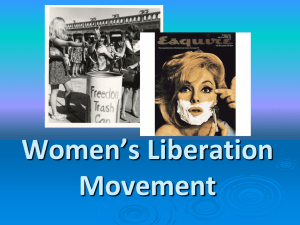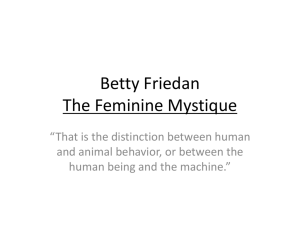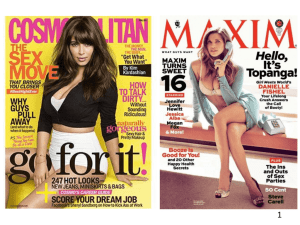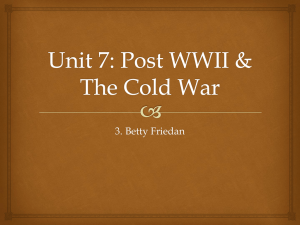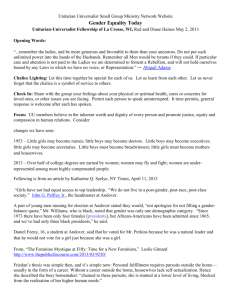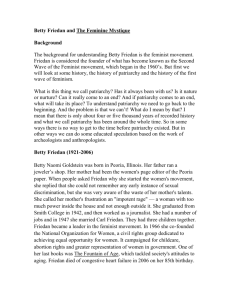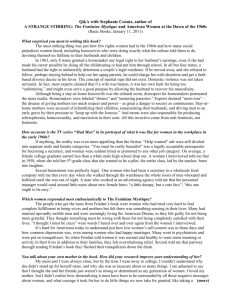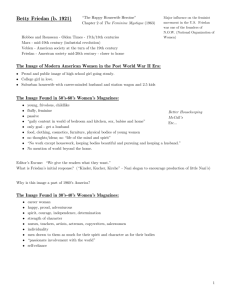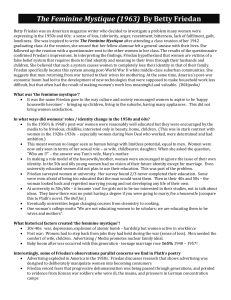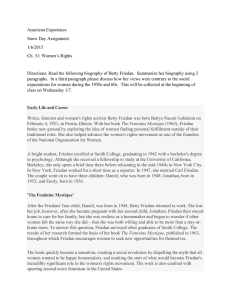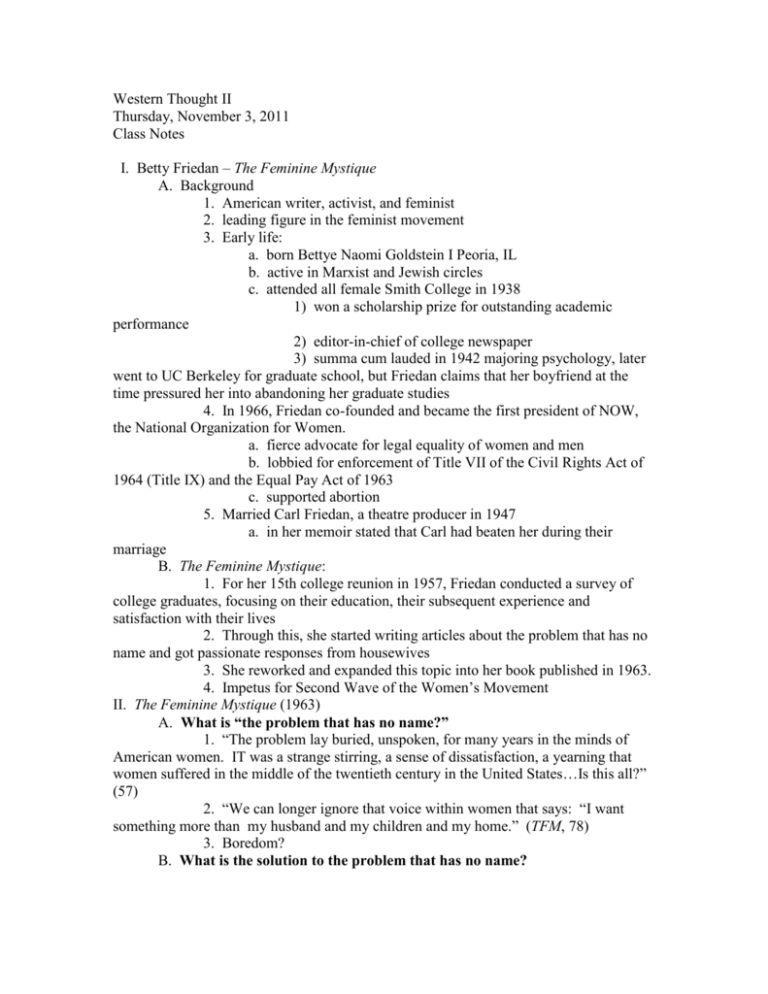
Western Thought II
Thursday, November 3, 2011
Class Notes
I. Betty Friedan – The Feminine Mystique
A. Background
1. American writer, activist, and feminist
2. leading figure in the feminist movement
3. Early life:
a. born Bettye Naomi Goldstein I Peoria, IL
b. active in Marxist and Jewish circles
c. attended all female Smith College in 1938
1) won a scholarship prize for outstanding academic
performance
2) editor-in-chief of college newspaper
3) summa cum lauded in 1942 majoring psychology, later
went to UC Berkeley for graduate school, but Friedan claims that her boyfriend at the
time pressured her into abandoning her graduate studies
4. In 1966, Friedan co-founded and became the first president of NOW,
the National Organization for Women.
a. fierce advocate for legal equality of women and men
b. lobbied for enforcement of Title VII of the Civil Rights Act of
1964 (Title IX) and the Equal Pay Act of 1963
c. supported abortion
5. Married Carl Friedan, a theatre producer in 1947
a. in her memoir stated that Carl had beaten her during their
marriage
B. The Feminine Mystique:
1. For her 15th college reunion in 1957, Friedan conducted a survey of
college graduates, focusing on their education, their subsequent experience and
satisfaction with their lives
2. Through this, she started writing articles about the problem that has no
name and got passionate responses from housewives
3. She reworked and expanded this topic into her book published in 1963.
4. Impetus for Second Wave of the Women’s Movement
II. The Feminine Mystique (1963)
A. What is “the problem that has no name?”
1. “The problem lay buried, unspoken, for many years in the minds of
American women. IT was a strange stirring, a sense of dissatisfaction, a yearning that
women suffered in the middle of the twentieth century in the United States…Is this all?”
(57)
2. “We can longer ignore that voice within women that says: “I want
something more than my husband and my children and my home.” (TFM, 78)
3. Boredom?
B. What is the solution to the problem that has no name?
1. “To face the problem is not to solve it. But once a woman faces it, as
women are doing today all over America without much help from the experts, once she
asks herself “What do I want to do?” she begins to find her own answers.
a. self definition rather than letting society define you
2. “The only way for a woman, as for a man, to find herself, to know
herself as a person, is by creative work of her own. There is no other way. But a job, any
job, is not the answer – in fact, it can be part of the trap. Women who do not look for
jobs equal to their actual capacity, who do not let themselves develop the lifetime
interests and goals which require serious education and training, who take a job at twenty
or forty to “help out at home” are walking to a nonexistent future.” (472)
C. How might this problem that Friedan discusses relate to Freud’s concept
of neurosis?
1. Society placing expectations on women in terms of behavior,
occupation.
2. “New Neuroses are being seen among women-and problems as yet
unnamed as neuroses – which Freud and his followers did not predict, with physical
symptoms, anxieties, and defense mechanisms equal to those caused by sexual
repression.” (FM, 75)
D. How do the types of fictional stories in mass women’s magazines change
from the 1940’s to the 1950’s and 1960’s? What does this transformation tell us
about the goals and aspirations of women during these two respective time periods?
1. 1930’s – heroines marching toward some goal or vision of their own,
struggling with some problem of work or the world, when they found their man. And this
New Woman, less fluffily feminine, so independent and determined to find a new life of
her own, was the heroine of a different kind of love story. Her passionate involvement
with the world, her own sense of herself as an individual, her self-reliance, gave a
different flavor to her relationship with the man.” (FM, 86)
2. 1950’s and 1960’s – By the end of 1949, only one out of three heroines
in the women’s magazines was a career woman.
a. “These new happy housewife heroines seem strangely younger
than the spirited career girls of the thirties and forties…They have no vision of the future,
except to have a baby.” (FM, 93)
b. “The Sandwich Maker” (Ladies Home Journal, April 1959)
(59)
3. In earlier times the image of woman was split in two: good, pure
woman on the pedestal and the whore of the desires of the flesh. The split in the new
image opens a different fissure – the feminine woman, whose goodness includes the
desires of the flesh, and the career woman, whose evil includes every desire of the
separate self. The new feminine morality story is the exorcising of the forbidden career
dream.” (FM, 95)
E. How does Friedan define the “feminine mystique?”
1. “The feminine mystique says that the highest value and the only
commitment for women is the fulfillment of their own femininity. It says that the great
mistake of Western culture, through most of its history, has been the undervaluation of
this femininity. It says this femininity is so mysterious and intuitive and close to the
creation and origin of life that man-made science may never be able to understand it. But
however special and different, it is in no way inferior to the nature of man; it may even in
certain respects be superior.”
2. Fulfillment as a woman had only one definition - Occupation:
housewife
F. What was the movement of “Togetherness?”
1. “Coined by the publishers of McCall’s in 1954, the concept
“togetherness” was seized upon avidly as a movement of spiritual significance by
advertisers, ministers, newspaper editors.” (FM, 97)
2. “The end of the road is togetherness, where the woman has no
independent self to hide even in guilt; she exists only for and through her husband and
children.” (97)
G. What was the socially prescribed role for women during the 1950’s and
1960’s? How did this role develop?
1. “As the young men returned from the war, a great many women writers
dropped out of the field. The young women started having a lot of children, and stopped
writing. The new writers were all men, back from the war, who had been dreaming about
home, and a cozy domestic life…The new magazine pros were men, and a few
women…Today, the deciding voice on most of these magazines is cast by men.” (105)
2. Serious fiction writers of either sex disappeared from the masscirculation women’s magazines.
a. “Writing for these magazines, I was continually reminded by
editors” that women have to identify.” (103)
1) couldn’t identify with politics or world issues
2) could identify with life altering injuries
3. “Woman’s political job is to “inspire in her home a vision of the
meaning life and freedom…to help her husband find values that will give purpose to his
specialized daily chores…to teach her children the uniqueness of each individual human
being.” (113)
H. What did so many American women, with the ability and education to
discover and create, go back home again, to look for “something more” in
housework and rearing children?
1. “The Sexual Sell” Chapter 9: What powers it all?
a. “Too many women getting educated. Don’t want to stay home.
Unhealthy. If they all get to be scientists and such, they won’t have time to shop. But
how can we keep them home. They want careers now. We’ll liberate them to have
careers at home. We’ll make home-making creative.” (FM, 300)
2. Advertising, manipulations: Properly manipulated American
housewives can be given the sense of identity, purpose, creativity, the self realization
even the sexual joy they lack by the buying of things. I suddenly saw American women
as victims of that ghastly gift, that power at the point of purchase.” (301)
3. Three types: The True Housewife Type” (51%), “The Career Woman
and Would Be Career Woman” (minority), “The Balanced Homemaker” – ideal type
represents the market with the greatest future potential, it would be to the advantage of
the appliance manufacturer to make more and more women aware of the desirability of
belonging to this group. Educate them through advertising that it is possible to have
outside interests and become alert to wider intellectual influences. The art of god
homemaking should be the goal of every normal woman.” (303)
I. Friedan writes that one of the problems for American women was a lack of
“private image.” What does she mean by this?
1. identity crisis – “I think that this has been the unknown heart of
woman’s problem in America for a long time, this lack of a private image. Public images
that defy reason and have very little to do with women themselves have had the power to
shape too much of their lives. These images would not have such power, if women were
not suffering a crisis of identity.” (FM, 131)
2. Women don’t know what they want to be: anecdote about girls afraid
of self definition, fear of becoming their mothers, just want to be popular
J. How does the notion of motherhood fit into Friedan’s discussion on
women?
1. Overinvestment of mothers in their children, “The cult of the child”
still resonates with women who have chosen not to work outside the home and those who
have, both of whom feel under cultural fire.” (15)
2. “Not long ago Dr. Spock confessed, that Russian children whose
mothers usually have some purpose in their lives besides motherhood – they work in
medicine, science, education, industry, government, art – seemed somehow more stable,
adjusted, mature, than American children, whose full time mothers do nothing but worry
about them.” (287)
K. How has society changed since the notion of “the problem that has no
name”? How have gender roles changed since then?
1. “Metamorphosis: Two Generations Later”: It’s the men who have to
break through to a new way of thinking about themselves and society.” (17)
2. “The fact is women are now carryings some 50% of the income earning
burden in some 50% of households. Women are now nearly 50 of the labor force. 59%
of women work at jobs outside the home, including the mothers of young children. And
omen’s wages are now about 72% of men’s. They are not equal at the top; most of the
CEO’s law partners, hospital heads, full professors, cabinet members, judges and police
chiefs are still men. But women are now represented in all levels below the very top.
And more Americans now work for companies owned and run by women than by the
Fortune 500.” (22)
3. Violence against women seems to be increasing in the US partly
because women are reporting as abuse what they used to accept passively as private
shame, but maybe also because men’s increasing frustration and desperation is being
taken out on women.” (25)

